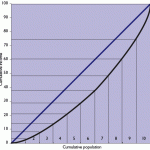 There are a few local stores I visit often – enough so that they know my name, preferences, boyfriend’s name, work/travel schedule, and even my pets. They call me on my cell phone when something new is available that they know I’ll love. They make sure I know in advance about events they’re holding. In return, I’m glad to pick up the phone when I see that they’re calling.
There are a few local stores I visit often – enough so that they know my name, preferences, boyfriend’s name, work/travel schedule, and even my pets. They call me on my cell phone when something new is available that they know I’ll love. They make sure I know in advance about events they’re holding. In return, I’m glad to pick up the phone when I see that they’re calling.
These are the experts in personalization and targeted messaging. They are the kings and queens of the customer relationship. And the big box retailers of the world are tremendously jealous of them.
Continue reading

 Let’s say you have a process that requires a start date, but may or may not have an end date, as a parameter feeding in. How can you accomplish this in Netezza via a stored procedure? The internet has not had great answers to this question but it’s not as hard as some other programmers make it out to be. So today we tackle optional arguments – in easy mode.
Let’s say you have a process that requires a start date, but may or may not have an end date, as a parameter feeding in. How can you accomplish this in Netezza via a stored procedure? The internet has not had great answers to this question but it’s not as hard as some other programmers make it out to be. So today we tackle optional arguments – in easy mode. I’ve recently come to love (read:be obsessed with) windowing functions in my coding. They’re just so useful and practical.
I’ve recently come to love (read:be obsessed with) windowing functions in my coding. They’re just so useful and practical. 
 Imagine, if you will, begin able to calculate the time between visits to a website, transactions in a store, logs from a punch-clock, etc. in just one step. Well, I have found the way!
Imagine, if you will, begin able to calculate the time between visits to a website, transactions in a store, logs from a punch-clock, etc. in just one step. Well, I have found the way!

 Slicing data into manageable chunks for viewing is crucial when you start dealing with more records than will fit in something like Excel (without PowerPivot, of course). One of the most common ways to look at data in a more easily-digestible manner is to use percentiles, or some derivative thereof, to group records based on a ranking. This allows you to then compare equal-sized groups to one another in order to form conclusions as to relative behavior.
Slicing data into manageable chunks for viewing is crucial when you start dealing with more records than will fit in something like Excel (without PowerPivot, of course). One of the most common ways to look at data in a more easily-digestible manner is to use percentiles, or some derivative thereof, to group records based on a ranking. This allows you to then compare equal-sized groups to one another in order to form conclusions as to relative behavior. There are a whole set of fields in the databases I’m using here that are tilde-delimited (~) varchar strings with a mess of key-value pairs, the values from which I really need. Unfortunately, since they are varying character lengths, in no particular set order within that field, it is impossible to substring your way efficiently through them. Thankfully, there is a RegEx genius on my team who produced a handy chuck of code that pgSQL can easily recognize, parse and process for pulling precisely what I need.
There are a whole set of fields in the databases I’m using here that are tilde-delimited (~) varchar strings with a mess of key-value pairs, the values from which I really need. Unfortunately, since they are varying character lengths, in no particular set order within that field, it is impossible to substring your way efficiently through them. Thankfully, there is a RegEx genius on my team who produced a handy chuck of code that pgSQL can easily recognize, parse and process for pulling precisely what I need.